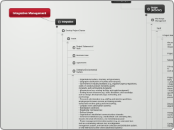Integration Management
Integration
Develop Project Charter
Inputs
Project Statement of
Work
Business Case
Agreements
Enterprise Environmental
Factors
• Organizational culture, structure, and governance;
• Geographic distribution of facilities and resources;
• Government or industry standards (e.g., regulatory agency regulations, codes of conduct, product standards, quality
standards, and workmanship standards);
• Infrastructure (e.g., existing facilities and capital equipment);
• Existing human resources (e.g., skills, disciplines, and knowledge, such as design, development, legal, contracting, and
purchasing);
• Personnel administration (e.g., staffing and retention guidelines, employee performance reviews and training records,
reward and overtime policy, and time tracking);
• Company work authorization systems;
• Marketplace conditions;
• Stakeholder risk tolerances;
• Political climate;
• Organization’s established communications channels;
• Commercial databases (e.g., standardized cost estimating data, industry risk study information, and risk databases); and
• Project management information system (e.g., an automated tool, such as a scheduling software tool, a configuration
management system, an information collection and distribution system, or web interfaces to other online automated systems)
Organizational Process
Assets
Initiating & Planning
○ Guidelines and criteria for tailoring the organization’s set of standard processes and
procedures to satisfy the specific needs of the project;
○ Specific organizational standards such as policies (e.g., human resources policies, health and
safety policies, ethics policies, and project management policies), product and project life cycles,
and quality policies and procedures (e.g., process audits, improvement targets, checklists, and
standardized process definitions for use in the organization); and
○ Templates (e.g., risk register, work breakdown structure, project schedule network diagram,
and contract templates).
Exec, Monitoring &
Control
○ Change control procedures, including the steps by which performing organization
standards, policies, plans, and procedures or any project documents will be modified, and
how any changes will be approved and validated;
○ Financial controls procedures (e.g., time reporting, required expenditure and disbursement
reviews, accounting codes, and standard contract provisions);
○ Issue and defect management procedures defining issue and defect controls, issue and
defect identification and resolution, and action item tracking;
○ Organizational communication requirements (e.g., specific communication technology
available, authorized communication media, record retention policies, and security
requirements);
○ Procedures for prioritizing, approving, and issuing work authorizations;
○ Risk control procedures, including risk categories, risk statement templates, probability and
impact definitions, and probability and impact matrix; and
○ Standardized guidelines, work instructions, proposal evaluation criteria, and performance
measurement criteria.
Closing
Project closure guidelines or requirements (e.g., lessons learned, final project audits, project evaluations,
product validations, and acceptance criteria).
Tools
Output
Develop Project Management
Plan
Input
Tools
Output
Direct and Manage Project
Work
Input
Tools
Output
Monitor and Control Project
Work
Input
Tools
Output
Perform Integrated Change
Control
Input
Tools
Output
Close Project or Phase
Input
Tools
Output
Floating topic
Scope
(PCDCVC)
Plan Scope
Management
Input
1 Project Management Plan
2 Project Charter
3 Enterprise Environmental
Factors
4 Organizational Process
Assets
Tools
1 Expert Judgement
2 Meetings
Output
Collect Requirements
Define Scope
Create WBS
Validate Scope
Control Scope
